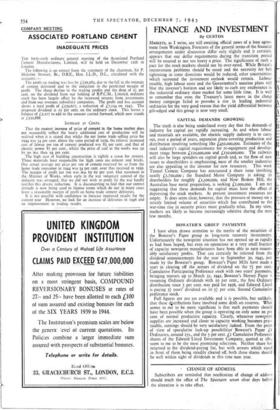FINANCE AND INVESTMENT
By CUSTOS
MAniars, as I write, are still awaiting official news of a loan agree- ment from Washington. Forecasts of the general terms of the financial arrangements under discussion differ only slightly and it certainly appears that our dollar requirements during the transition period will be assured at not too heavy a price. The significance of such d pact for the stock markets should not be over-rated. While Britain's reconversion problems should be eased and the necessity for belt tightening in some directions would be reduced, other uncertainties which surround the investment outlook would remain. Labour trouble, high labour costs and the Govermrfent's taxation plans still blur the investor's horizon and are likely to curb any exuberance in the industrial ordinary share market for some little time. It is well to remember that even the Treasury's latest move in the cheap money campaign failed to provoke a rise in leading industrial ordinaries for the very good reason that the yield differential between gilt-edged and this group is now very small.
CAPITAL DEMANDS GROWING
The truth is also being underlined every day that the demands of industry for capital are rapidly increasing. As and when labour and materials are available, the electric supply industry is to carry out, over a period of years, expansion plans covering production and distribution involving something like £45o,000,000. Estimates of the steel industry's capital requirements for re-equipment and develop- ment range between £120,000,000 and L150,000,000. The railways will also be large spenders on capital goods and, as the flow of new issues to shareholders is emphasising, most of the smaller industries are also appealing to the investor for new resources. This week Tunnel Cement Company has announced a share issue involving nearly Li,7oo,000 ; the Standard Motor Company is asking its shareholders for roughly ,C1,500,000, and New Broken Hill, the Australian base metal prop9sition, is seeking £i,000,000. I am not suggesting that these demands for capital must have the effect of depressing the stock markets. At present investment resources are ample. It does seem clear, however, that the pressure of money on a strictly limited volume of securities which has contributed to the war-time rise in security prices must gradually relax. In my view, markets are likely to become increasingly selective during the next few months.
BOWATER'S GROUP PAYMENTS
I have often drawn attention to the merits of the securities of the Bowater's Paper group as long-term recovery investments. Unfortunately the newsprint situation has not opened up as rapidly as had been hoped, but even on operations at a very small fraction of capacity newsprint manufacturers have been able to earn reason- ably satisfactory profits. That can certainly be inferred from the dividend announcements for the year to September 30, 1945, just made by the Bowater's group. Bowater's Paper Mills have made a start in clearing off the arrears of dividend on the 71 per cent. Cumulative Participating Preference stock with two years' payments, bringing matters up to March 31, II, Bowater's Mersey Paper is resuming Ordinary .dividends with to per cent., the first Ordinary distribution since 5 per cent, was paid for 1936, and Edward Lloyd is paying 31 years' dividend on its 51 per cent. Second Cumulative preference stock.
Full figures are not yet available and it is possible, but unlikely, that these distributions have involved some draft on reserves. What seems to me to be more significant is that such payments should have been possible when the group is operating on only some 2o per cent, of normal productive capacity. Clearly, whenever newsprint supplies are increased and closer to capacity working becomes prac- ticable, earnings should be very satisfactory indeed. From the point of view of speculative lock-up possibilities• Bowater's Paper kt Ordinaries, around 25s., and the 5 per cent. £i Cumulative Preference shares of the Edward Lloyd Investment Company, quoted at as., seem to me to be the most promising selections. Neither share has returned to the dividend-paying list, but with arrears which stand in front of them being steadily cleared off, both these shares should be well within sight of dividends at this time next year.






























 Previous page
Previous page